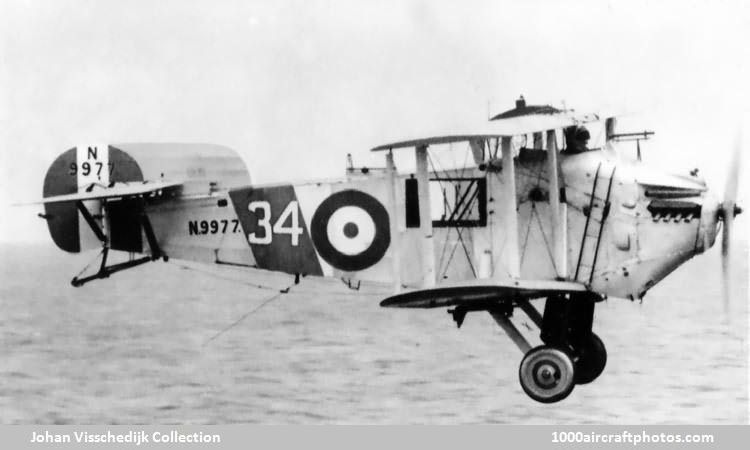06/30/2010. Remarks by Johan Visschedijk: "The Bison was to meet the British Air Ministry Specification 3/21 for a carrier based fleet spotter and reconnaissance aircraft. An order for three prototypes was placed with A.V. Roe & Co. Ltd., Manchester, in October 1921, together with three of the competing design from Blackburn Aircraft, the Blackburn R.1 Blackburn.
Designed by Roy Chadwick, there is no denying that the Bison, like other British naval aircraft of the early nineteen-twenties, was uncommonly ugly. The biplane had wooden fabric covered folding wings, while the steel tubes fuselage, covered with plywood and fabric, provided naval observers and wireless operators with an enormous cabin of unusually large cross-section and generous windows.
Power plant was a 450 hp Napier Lion II twelve-cylinder liquid-cooled W-engine, behind and above which sat the pilot in an open cockpit forward of the wings. A cockpit for a gunner armed with a Lewis gun on a Scarff ring was provided in the upper rear fuselage, an additional fixed forward-firing Vickers machine gun was mounted in the front. In the rear of the fuselage floating balloons were fitted, as well as a beacon to locate the aircraft in case of a crash into the sea.
The first prototype, s/n N153, had the upper wings directly mounted on the top of the fuselage, and first flew in September 1921. Although designed as a Fleet spotter-reconnaissance aircraft for deck-landing operations, the first production batch of twelve Avro 555A Bison Mk.I aircraft (s/n N9591 to N9602) entered service with the RAF No. 3 Squadron for coastal reconnaissance, replacing the Westland Walrus at Fort Brockhurst, Gosport, which it equipped from 1922 until April 1923.
However, the Bison had handling problems, caused by interference of the pilots cockpit with the airflow over the upper wing. This was resolved by revising the wing design of the second prototype, s/n M154, raising the center section of the upper wing by 2 ft (0.6 m) (transforming the one-bay aircraft into a two-bay), and removed dihedral from the upper wings, flying in this form on December 12, 1922. A number of Bison Mk.Is were modified to a similar standard, sometimes referred to as the Bison Mk.IA.
The last prototype, s/n N155, was similar to the second prototype and first flew June 30, 1923. It was assigned to the Wireless and Flight Photographic based in Farnborough, in 1924 it went to Gosport. A production Mk.I, s/n N9594, was fitted with floats and retractable wheels, and designated Avro 555B Bison Mk.IB, it was tested in amphibious operations, but tests proved the design was not suitable for seaborne use, It was subsequently fitted with a conventional landing gear.
In April 1924, No. 3 Squadron was broken up to form a number of Fleet Spotter Flights of the Fleet Air Arm, and the aircraft served on HMS Argus,HMS Eagle and Furious and on-shore at Hal Far, Malta, while training was conducted at Gosport, England. An additional 41 aircraft were produced, designated Avro 555C Bison Mk.II, s/n N9836-N9853, N9966-N9977, S1109-S1114, and S1163-S1167. These were delivered to the FAA between December 1924 and February 1927. In 1929 they were replaced by Fairey IIIF."
